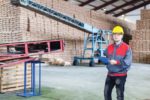Items Tagged with 'combustible dust'
ARTICLES
Preventing a dust fire
How can we optimize employee safety when handling combustible dust?
Read MoreEffective combustible dust removal
When a facility has multiple areas where combustible dusts are present, are central vacuum cleaning systems the only option?
Read MoreCombustible dust control
How will an industrial vacuum cleaner enhance safety and compliance?
Read More









